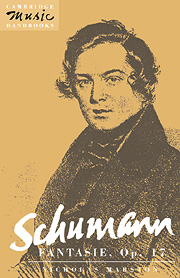Book contents
- Frontmatter
- Contents
- List of plates
- Preface
- Acknowledgements
- List of abbreviations
- 1 The compositional history of the Fantasie
- 2 ‘What's in a name?’ Genre and title in the Fantasie
- 3 Allusion and quotation in the Fantasie
- 4 Form in the first movement
- 5 Schlegel's leiser Ton and thematic unity in the Fantasie
- 6 Form in the second and third movements
- 7 The subsequent history of the Fantasie
- Notes
- Bibliography
- Index
- Plate section
3 - Allusion and quotation in the Fantasie
Published online by Cambridge University Press: 26 January 2010
- Frontmatter
- Contents
- List of plates
- Preface
- Acknowledgements
- List of abbreviations
- 1 The compositional history of the Fantasie
- 2 ‘What's in a name?’ Genre and title in the Fantasie
- 3 Allusion and quotation in the Fantasie
- 4 Form in the first movement
- 5 Schlegel's leiser Ton and thematic unity in the Fantasie
- 6 Form in the second and third movements
- 7 The subsequent history of the Fantasie
- Notes
- Bibliography
- Index
- Plate section
Summary
Schumann's early piano works abound in allusion. Broadly speaking, the allusion may be of two kinds: a work may allude to other musical works, whether of Schumann or another composer; or the allusion may be to nonmusical material, in which case we may speak of an extra-musical meaning enshrined in the work by means of allusion. An example of the former type is the appearance in Florestan from Carnaval of the theme from Papillons No. 1 (the theme also plays an important part in the finale of that work). By quoting quite literally from the earlier work here, Schumann alludes more generally to it as a whole: Papillons is imported into Carnaval. As examples of extra-musical allusion we might take the verbal references to the dying away of the noise of carnival night (‘Das Geräusch der Faschingsnacht verstummt’) and to the striking of the clock (‘Die Thurmuhr schlägt sechs’) written into the finale of Papillons, a movement which is based closely on a scene from Jean Paul's novel Flegeljahre and which alludes musically to the Grossvatertanz traditionally played at the end of balls. The extra-musical meaning of the ‘Sphinx’ motives Al–C–B and A–B–C–B on which Carnaval is largely based resides in their being the ‘musical’ letters in Schumann's surname and also a ‘spelling’ of ASCH, the birthplace of Ernestine von Fricken, to whom he was briefly engaged. (B is called H in German, while Al is As and El is Es, pronounced like ‘S’.)
The Fantasie, and especially its first movement, is rich in allusions of various kinds.
- Type
- Chapter
- Information
- Schumann: Fantasie, Op. 17 , pp. 34 - 42Publisher: Cambridge University PressPrint publication year: 1992



